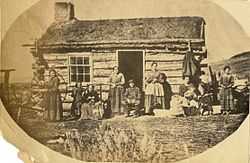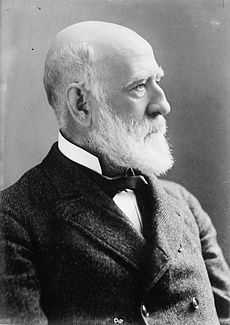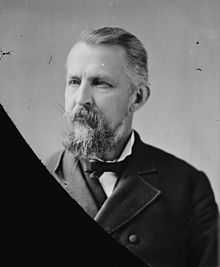Edmunds–Tucker Act
The Edmunds–Tucker Act of 1887 was an Act of Congress that focused on restricting some practices of The Church of Jesus Christ of Latter-day Saints (LDS Church). It was passed in response to the dispute between the United States Congress and the LDS Church regarding polygamy. The act is found in US Code Title 48 & 1461, full text as 24 Stat. 635, with this annotation to be interpreted as Volume 24, page 635 of United States Statutes at Large. The act is named after its congressional sponsors, Senator George F. Edmunds of Vermont and Congressman John Randolph Tucker of Virginia. The act was repealed in 1978.
History
The act disincorporated both the LDS Church and the Perpetual Emigration Fund on the grounds that they fostered polygamy. The act prohibited the practice of polygamy and punished it with a fine of from $500 to $800 and imprisonment of up to five years. It dissolved the corporation of the church and directed the confiscation by the federal government of all church properties valued over a limit of $50,000. The act was enforced by the U.S. Marshal and a host of deputies.
| Mormonism and polygamy |
|---|
 A Mormon polygamist family in 1888. |
|
Reynolds v. US • Cannon v. US • Clawson v. US • Davis v. Beason • Late Corp of the LDS Church v. US • Cleveland v. US • Brown v. Buhman • List of polygamy court cases |
|
Related articles |
| Latter Day Saints portal |
The act:
- Disincorporated the LDS Church and the Perpetual Emigrating Fund Company, with assets to be used for public schools in the Territory.[1]
- Required an anti-polygamy oath for prospective voters, jurors and public officials.
- Annulled territorial laws allowing illegitimate children to inherit.
- Required civil marriage licenses (to aid in the prosecution of polygamy).
- Abrogated the common law spousal privilege for polygamists, thus requiring wives to testify against their husbands.[2]
- Disenfranchised women (who had been enfranchised by the Territorial legislature in 1870).[3]
- Replaced local judges (including the previously powerful Probate Court judges) with federally appointed judges.
- Abolished the office of Territorial superintendent of district schools, granting the supreme court of the Territory of Utah the right to appoint a commissioner of schools. Also called for the prohibition of the use of sectarian books and for the collection of statistics of the number of so-called gentiles and Mormons attending and teaching in the schools.[4]
In 1890 the U.S. Supreme Court upheld the seizure of Church property under the Edmunds–Tucker Act in Late Corporation of the Church of Jesus Christ of Latter-Day Saints v. United States.
This act was repealed in 1978.[5][6]
See also
- 1890 Manifesto
- Edmunds Act (1882)
- Timeline of civil marriage in the United States
- LDS Church v. United States (1890)
- Morrill Anti-Bigamy Act (1862)
- Poland Act (1874)
- Reynolds v. United States (1879)
- Second Manifesto (1904)
- Smoot Hearings (1903–1907)
- Utah War (1857–1858)
- Women's suffrage in Utah
References
- ↑ L. Rex Sears, "Punishing the Saints for Their "Peculiar Institution": Congress on the Constitutional Dilemmas," 2001 Utah L. Rev. 581
- ↑ Embry, Jessie L. (1994), "Polygamy", in Powell, Allan Kent, Utah History Encyclopedia, Salt Lake City, Utah: University of Utah Press, ISBN 0874804256, OCLC 30473917
- ↑ Women's Suffrage in Utah Jean Bickmore White, Utah History Encyclopedia
- ↑ Edmunds–Tucker Act: Section 25
- ↑ The practice of polygamy: legitimate free exercise of religion or legitimate public menace? Revisiting Reynolds in light of modern constitutional jurisprudence Richard A. Vazquez, Journal of Legislation & Public Policy (New York University School of Law), Volume 5, Number 1, Fall 2001
- ↑ Past and Present Proposed Amendments to the United States Constitution Regarding Marriage Edward Stein, Washington University Law Quarterly, Volume 82, Number 3, 2004
Further reading
- "Gospel Topics: The Manifesto and the End of Plural Marriage", LDS.org (LDS Church), retrieved 2014-10-22

